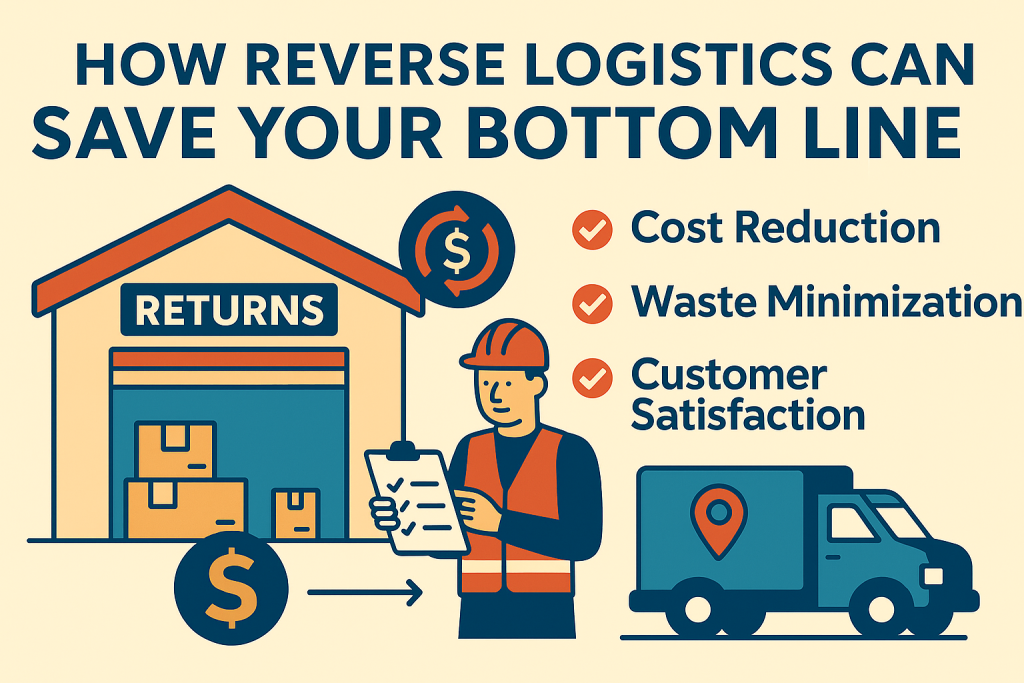By Martin Vassilev / 16 Aug, 2025

Reverse logistics refers to the process of moving goods from the end consumer back to the seller or manufacturer for returns, recycling, refurbishing, or disposal. Unlike traditional forward logistics, which focuses on delivering products to customers, reverse logistics is all about optimizing the return flow to recover value, reduce waste, and improve customer satisfaction. In today’s competitive market—where e-commerce returns account for over 30% of purchases—mastering reverse logistics is no longer optional; it’s essential for protecting your profitability.
By implementing a strategic reverse logistics process, businesses can not only cut unnecessary costs but also create opportunities for revenue recovery and brand loyalty. This article breaks down the key benefits, strategies, and technologies that make reverse logistics a game-changer for your bottom line.
Every return involves costs—inspection, repackaging, restocking, or disposal. Without a clear reverse logistics strategy, these costs can skyrocket. By centralizing return centers and using automated warehouse management systems, companies can streamline the process, minimize labor, and reduce transit expenses.
For instance, integrating AI-driven return forecasting, as discussed in How AI is Transforming the Logistics Industry in 2025, can help businesses predict return volumes and adjust resources accordingly.
Returned products don’t have to mean lost revenue. Many items can be refurbished, repackaged, and resold at a discount or in secondary markets. This approach turns potential waste into profit, improving both cash flow and sustainability metrics.
Efficient reverse logistics ensures that returned products re-enter inventory quickly, reducing the risk of obsolescence. This is particularly critical for seasonal items, tech products, and perishable goods.
Centralizing your returns into a single hub allows for faster processing, better quality control, and lower shipping costs.
Businesses leveraging returns management services like ByExpress Returns Management benefit from real-time tracking, automation, and optimized carrier selection.
From barcode scanning to IoT-enabled tracking devices, technology reduces bottlenecks and increases visibility across the reverse supply chain. Companies investing in real-time warehouse tracking systems see significantly lower operational costs.
Customers are increasingly eco-conscious. By implementing green logistics practices—such as recycling packaging materials and refurbishing electronics—businesses can boost brand perception while lowering waste management costs. For more on sustainable strategies, see The Role of Green Logistics in Modern Warehousing.
An efficient reverse logistics process doesn’t just save money—it builds trust. Customers who experience hassle-free returns are more likely to repurchase and recommend the brand. Research shows that 92% of consumers will buy again if the return process is easy.
A clear, customer-friendly return policy supported by fast, accurate processing can be the differentiator in crowded markets. Offering options such as drop-off points, prepaid shipping labels, and instant refunds ensures a positive post-purchase experience.
Using predictive analytics to anticipate returns helps allocate staffing, warehouse space, and transportation resources efficiently.
Bypassing long storage periods for returned goods through cross-docking (learn more in What Is Cross-Docking and Should You Use It?) speeds up the resale or recycling process and reduces handling costs.
Not all returns are equal. High-value, high-demand items should be prioritized for quick resale, while low-value or damaged items can be directed toward recycling or liquidation.
Online portals and automated RMA (Return Merchandise Authorization) systems reduce administrative labor and improve accuracy.
Sustainability is no longer just a PR strategy—it’s a profit driver. Reverse logistics allows businesses to:
Reduce landfill waste through recycling programs.
Lower carbon emissions by optimizing return transport routes.
Improve brand perception by adopting eco-friendly practices.
In fact, aligning reverse logistics with green warehousing principles can attract eco-conscious consumers and open the door to government incentives for sustainable operations. According to the U.S. Environmental Protection Agency (EPA), reusing and recycling materials significantly reduces environmental impact while lowering costs.
Partnering with a specialized 3PL provider can dramatically improve the efficiency and profitability of reverse logistics. Experienced providers like ByExpress offer:
Dedicated returns management systems.
Access to advanced tracking technology.
Bulk processing capabilities to reduce per-unit handling costs.
For businesses considering outsourcing, see Why Outsourcing Warehousing Is More Cost-Effective Than In-House Management for cost-benefit insights.
To ensure that reverse logistics is contributing positively to the bottom line, track key performance indicators (KPIs) such as:
Return rate (% of sales returned)
Processing time (average days from return to resolution)
Value recovery rate (percentage of returned goods resold)
Disposal cost per unit
Customer satisfaction with returns process
Tracking these metrics aligns reverse logistics with broader supply chain efficiency goals (learn more here).
Consider a mid-sized online retailer facing 25% return rates during peak seasons. By implementing:
Centralized return hubs
AI-driven forecasting
Cross-docking for high-demand returned items
… they reduced processing times by 40% and increased recovered product value by 18%, resulting in a $2.5M improvement to the bottom line within a year.
Reverse logistics is far more than a necessary cost—when managed effectively, it’s a profit-boosting, brand-building, and sustainability-enhancing strategy. Companies that invest in robust reverse logistics infrastructure not only protect their margins but also future-proof their supply chains in an era of increasing consumer expectations and environmental awareness.
For tailored reverse logistics solutions that align with your business goals, visit our Contact Page to speak with a logistics specialist.

“Thanks to Byexpress all my shipping and fulfillment costs are in line now”

“All my issues were solved by Byexpress team that I had with pervious 3pl provider.”

“Thank you Byexpress team could not done it without you guys.”

“Their integration and customer service were the key for me”

“Outstanding delivery service! The package was well-packaged, and
the delivery team was professional and courteous”

“Great and knowledgeable team to work with.”

Thanks, guys, for reducing my shipping rates
Ottawa Office
2411 Holly Lane
Ottawa, ON, K1V 7P2
Toronto Office
13-280 West Beaver Creek Road Unit #136
Richmond Hill, ON, L4B 3Z1
Alexandria Office
173 Kenyon Street West
Alexandria, ON, K0C 1A0
Montreal Office
4388 Saint-Denis Street Unit #200
Montreal, QC, H2J 2L1
California Office
155 North Riverview Drive
Anaheim Hills, CA, 92808
Call Us
Toll-Free: 1-866-744-7122
Local : 613-739-3000
Email Us
Multilingual Services










